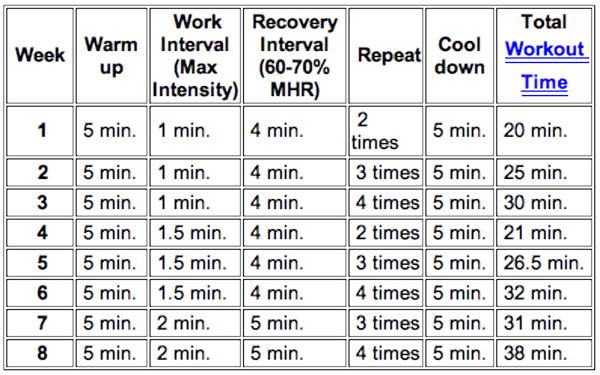Many in the field of sports science are beginning to cite the numerous benefits of high-intensity interval training (HIIT) for competitive and recreational athletes alike. For example, high-intensity training should be included in the training program of all endurance athletes, says Seiler from the University of Agder. He recommends 1 to 2 sessions a week in order to receive performance benefits without over stressing the body. However, given that the range of HIIT workouts and fitness of athletes varies greatly, it is difficult to say this amount will suit everyone. Instead, the duration of high-intensity interval training sessions must be tailored around the needs of the athlete, and the type of HIIT exercise must suit the particular endurance activity or sport for which the athlete is training, to ensure he or she can meet all of the demands of that activity.
General Guidelines
HIIT workouts are designed for athletes who want to improve their cardiovascular fitness and endurance without losing muscle mass. The workouts are very challenging, and are not safe for untrained (or even certain moderately-trained) individuals. Spark People recommends that the athlete be able to exercise for 20 to 30 minutes at 70% to 85% of maximum heart rate without experiencing problems or exhaustion. Additionally, if the athlete is unable to maintain around 60% to 70% of his or her maximum heart rate during warm up, cool down and recovery phases, he or she is clearly trying to work harder than the body is yet able.
It is important to begin with far less than is the ultimate training goal, as HIIT is initially very physically demanding. A common mistake exercisers make is immediately incorporating 3 or 4 HIIT sessions per-week into their training schedule. Weight Loss and Training recommends starting with 1 to 2 sessions a week; if athletes are able to do more, this is a clear sign that they are not working at the lactate (anaerobic) threshold.
HIIT in Action
By way of example, here is an 8-week progressive HIIT program taken from the Spark People Website (NB: the “Repeat” column highlights the number of times per week the program should be conducted).
This regimen should be initially carried out once or twice a week, although repetitions and durations can be altered to suit each athlete’s needs and current cardio fitness abilities. After the final week of the program, the athlete can choose to continue increasing duration of intervals, number of intervals or both, depending upon his or her particular needs.
Serious competitive athletes may want to adhere to the 80/20 rule with respect to lower-level continuous training and HIIT, with 80% of training performed at sub-lactate intensities, and 20% high- intensity training. In such a scenario, HIIT would not exceed 1 or 2 weekly sessions.
So what’s the final word? For most athletes, an appropriate HIIT workout is anything that challenges the body without being overly-exhausting.
